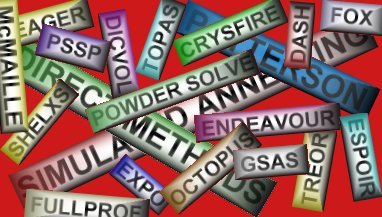CCP14 Homepage
What's New
Known Methods
The Samples
Download Data
Poster

Deadline was June 30, 1998
Summary :
70 download of data (see full connection
statistics)
4 participants
1 submission on sample 1 (inorganic)
4 submissions on sample 2 (pharmaceutical)
See "X-raying
the Web", a paper written by David Bradley about the SDPDRR results,
and published by ChemWeb.
Post-deadline submissions are welcome, but will be analyzed in a different way (you should not consult the organizer's results ;-)
The aim of this Round Robin is to compare efficiency of methods for structure determination from powder diffractometry (SDPD).
Two cases are offered to your attention, ensuring that every participant will use the same data.
We believe the structures to be solvable.
1st Sample is an inorganic phase, 2nd is a pharmaceutical. The supplied data comes from conventional X-rays (Cu K-alpha) and synchrotron radiation (medium resolution).
This is not a Round Robin on chemical analysis, indexing or Rietveld method. Therefore, formula, cell and possible space groups are given.
At this date, you should have completed and returned the final form.
As usual for a Round Robin such as this, confidentiality will be ensured. It is important to mention this given the incentive for creating the Round Robin was due to the relatively highly charged atmosphere of some Rietveld Mailing List discussions. Participants who submit a result will receive a unique participant number by which their submission will be referred by. Participant names are initially stripped from submitted results, and result sets stored and discussed internally by participant number. Referring to results by participant number during the internal analysis process helps ensure that when discussed or published, no inadvertant "verbal gaffs" occur associating/victimising individuals with individual datasets. It is the result sets and methodology which is important to the possible success of the Round Robin. (i.e., result sets submitted via intermediatory penguins via Antartic internet accounts will be accepted! :-) ) In the case of all submissions (including negative findings) participants have the option of submitting results "anonymously" (i.e., their names and institutions will not be noted as Round Robin participants).
This is primarily for the benefit of students and/or people who fear
a negative finding may be used to "inappropriately" haunt them at a later
date. Given the above mentioned "charged opinions", this may not seem an
unreasonable conclusion. Any procedural flaws (and successes) evident on
completion of the Round Robin will be put on the web so others intending
these types of studies can learn from our mistakes.
Thus only the individual participants will be able to recognise their
own results. This is a sincere attempt of a Round Robin of this nature,
and it only has the chance of generating representative results if participants
are confident of the aims of the Round Robin organisers to objectively
collate and report the results.
Potential participants are encouraged (even if relatively new, or complete
novices) to give this their best shot and submit their results. It is suggested
that supervisors may like to give these problems to students for submission
as examples of non-contrived "real world" problems. Even if the result
or conclusion is that one or both structures are not solvable using certain
methods or approaches, or only a partial structure was obtained; this is
useful information for the Round Robin. It is possible for an individual
to submit multiple results performed by different methods. It is not possible
to withdraw or replace a submission, but amended results can be submitted
as distinct results.
A summary of results will be presented at the invited talk on "Trends
in Structure Determination from Powder Diffraction" at the ECM-18
meeting in Prague.
Copyright © 1998 L.M.D Cranswick & A. Le Bail
[CCP14 HomepageALB Crystallography]

